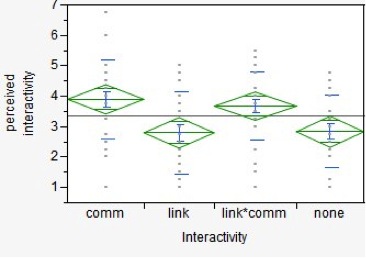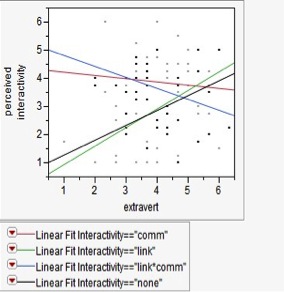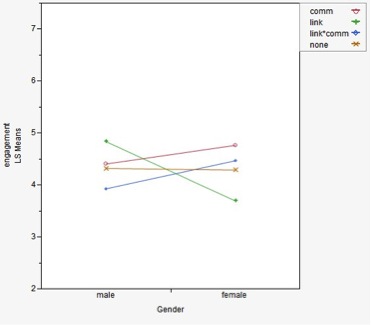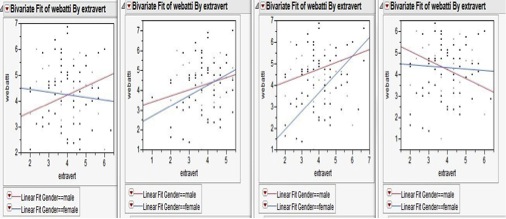Media Effects Research Lab - Research Archive
Does sociability make a difference?
Student Researcher(s)
Yan Huang (Ph.D Candidate);
Ariel Johnson (Masters Candidate);
Zhiyao Ye (Masters Candidate);
Faculty Supervisor
INTRODUCTION
The growth of sophisticated interactive website features has placed interactivity on a priority research agenda across disciplines. There are two dimensions of interactivity: Human computer interaction (HCI) and computer-mediated communication (CMC). From the cue-effects perspective, the research examines the different effects of HCI and CMC interactivity on user engagement and web attitudes, and the role of sociability and gender. Ninety-nine undergraduate students participated in a lab experiment using designed (MovieHulix) web stimuli with four interactivity conditions.
RESEARCH QUESTION / HYPOTHESES:
RQ1: For internet users, controlling for gender and sociability, what is the relationship between types of interactivity and level of perceived interactivity/user engagement/ user attitude?
H1: Users in the CMC condition will perceive a higher level of interactivity than users in the HCI condition will.
H2: Users in the CMC condition will be more engaged than users in the HCI condition will.
H3: Users in the CMC condition will have more positive attitudes towards the website than users in the HCI condition will.
H4: The higher the level of perceived interactivity, the higher the level of user engagement.
H5: The higher the level of user engagement, the more positive the user attitude.
H6: The higher the level of perceived interactivity, the more positive the user attitude.
H7a: Users’ sociability moderates the effects of interactivity on perceived interactivity.
H7b: Users’ sociability moderates the effects of interactivity on user engagement.
H7c: Users’ sociability moderates the effects of interactivity on user engagement.
H8a: Gender moderates the effects of interactivity on perceived interactivity.
H8b: Gender moderates the effects of interactivity on user engagement.
H8c: Gender moderates the effects of interactivity on user attitude towards the website.
METHOD
In order to answer our research question and test our hypotheses, we conducted a 2 (absence vs. presence of HCI) × 2 (absence vs. presence of CMC) between-subjects experiment, wherein each participant was randomly assigned to one of the four conditions (place Figures 2-5 here) and exposed to one web page pertaining to six newly released movies in different formats. Participant ages ranged from 18-45, average age 22.3. The sample was mostly Caucasian students a total of 54 males and 45 females.
RESULTS
In sum, we found that perceived interactivity is highly related to appearance of comment function instead of appearance of hyperlinks. Participants perceived higher levels of interactivity when they were exposed to comment function, but our results failed to show the effects of hyperlinks.

Males showed more interest in hyperlinks while females were more engaged to the comment function.


Further, we concluded that gender and sociability are two important moderators in the relationship between interactivity and user engagement and their attitudes toward the website.
Also, people who were more sociable showed a more positive attitude in all conditions except HCI × CMC condition. Moreover, the results indicated that in the in the highest level of interactivity condition, wherein both hyperlinks and comment function were offered, our participants did not perceive the highest level of interactivity nor reported the highest level of engagement, and also did not give the best evaluation of our web site.

DISCUSSION/ CONCLUSION
The goal of this study was to explore the relationship between interactivity, perceived interactivity, and user attitude/engagement. The results of this research present the opportunity for several theoretical and practical implications. First of which, this research contributes to existing scholarship by examining sociability as a moderator for the aforementioned variables. This study lends support to the existing data that indicate gender differences in attitudes toward interactive technological features. The results of this study have practical implication for web designers to consider gender and extraversion levels of target audiences in order to ensure optimal user experience. Future research should expound upon the limitations of this study and continue to consider personal characteristics as a moderator for interactivity on perceived interactivity, engagement, and web attitude.
For more details regarding the study contact
Dr. S. Shyam Sundar by e-mail at sss12@psu.edu or by telephone at (814) 865-2173

